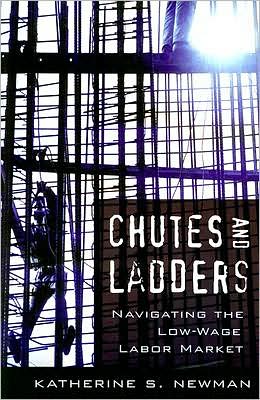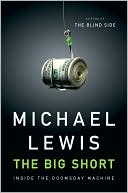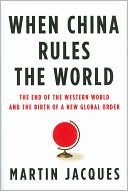Chutes and Ladders: Navigating the Low-Wage Labor Market
Now that the welfare system has been largely dismantled, the fate of America's poor depends on what happens to them in the low-wage labor market. In this timely volume, Katherine S. Newman explores whether the poorest workers and families benefited from the tight labor markets and good economic times of the late 1990s. Following black and Latino workers in Harlem, who began their work lives flipping burgers, she finds more good news than we might have expected coming out of a high-poverty...
Search in google:
Now that the welfare system has been largely dismantled, the fate of America's poor depends on what happens to them in the low-wage labor market. In this timely volume, Katherine S. Newman explores whether the poorest workers and families benefited from the tight labor markets and good economic times of the late 1990s. Following black and Latino workers in Harlem, who began their work lives flipping burgers, she finds more good news than we might have expected coming out of a high-poverty neighborhood. Many adult workers returned to school and obtained trade certificates, high school diplomas, and college degrees. Their persistence paid off in the form of better jobs, higher pay, and greater self-respect. Others found union jobs and, as a result, brought home bigger paychecks, health insurance, and a pension. More than 20 percent of those profiled in Chutes and Ladders are no longer poor.A very different story emerges among those who floundered even in a good economy. Weighed down by family obligations or troubled partners and hindered by poor training and prejudice, these "low riders" moved in and out of the labor market, on and off public assistance, and continued to depend upon the kindness of family and friends.Supplementing finely drawn ethnographic portraits, Newman examines the national picture to show that patterns around the country paralleled the findings from some of New York's most depressed neighborhoods. More than a story of the shifting fortunes of the labor market, Chutes and Ladders asks probing questions about the motivations of low-wage workers, the dreams they have for the future, and their understanding of the rules of the game. D.S. Pierson - Choice Newman‘s important contribution to the literature on the impact of the low-wage job market and the dismantling of the welfare system follows a group of workers from the fast food industry in Harlem over a ten year span of time. Her ethnographic approach reveals the barriers faced by this group of workers and the different pathways utilized to attain upward mobility in the labor and wage structure. Newman...compares this sample and conclusions with a national representative sample from the Survey of Income and Program Participation during the same time period. The data analysis indicates that workers from poor and near-poor households experienced substantial upward mobility. This finding is confirmed for households that found employment in what are considered dead-end jobs. The increase in household income does not lift them from poverty, but the ethnographic analysis indicates the changes in households that occurred during this period. The combination of qualitative and quantitative data opens a discussion of mechanisms for policymakers to deal with the issue of work and the poverty population.
AcknowledgmentsPrologue1. Lives, in the Long RunPart I. Chutes and Ladders2. The Best-Case ScenarioKatherine S. Newman and Chauncy Lennon3. High Flyers, Low Riders, and the "Up but Not Out" Club4. All in the Family5. The National PictureHelen Connolly, Peter Gottschalk, and Katherine S. NewmanPart II. The Inside View6. Streetwise EconomicsVictor Tan Chen and Katherine S. Newman7. "This Is the Kind of Life I Want": Work and Welfare in the Boom Years8. Dreams, Deferred: Aspirations and Obstacles in Work and Family Life9. Opening the GatesAppendix A. Study DesignAppendix B. Sample DefinitionsAppendix C. Occupational Prestige Scores and the Socioeconomic IndexAppendix D. SIPP Analysis of Wage and Status ChangeNotesIndex
\ ChoiceNewman‘s important contribution to the literature on the impact of the low-wage job market and the dismantling of the welfare system follows a group of workers from the fast food industry in Harlem over a ten year span of time. Her ethnographic approach reveals the barriers faced by this group of workers and the different pathways utilized to attain upward mobility in the labor and wage structure. Newman...compares this sample and conclusions with a national representative sample from the Survey of Income and Program Participation during the same time period. The data analysis indicates that workers from poor and near-poor households experienced substantial upward mobility. This finding is confirmed for households that found employment in what are considered dead-end jobs. The increase in household income does not lift them from poverty, but the ethnographic analysis indicates the changes in households that occurred during this period. The combination of qualitative and quantitative data opens a discussion of mechanisms for policymakers to deal with the issue of work and the poverty population.\ — D.S. Pierson\ \ \ \ \ \ New York Times Book ReviewNewman is a patient and sympathetic reporter, and she asked her subjects deep questions about their work histories, their love lives, their politics and their dreams. A lot of what she heard from them will come as a surprise to anyone who has read much recent scholarship on the inner-city poor...Newman is not blind to the many disadvantages these former burger-flippers face in the marketplace, from outright racism to a lack of the casual social connections that middle-class Americans often use to find and land a job. The system really is sometimes rigged against these workers, and they know it. But despite all this, they speak persuasively and passionately about the way work, even rotten work, gives meaning to their lives. Stories like Adam's and Ebony's only confirm to them what they already believe: that anyone can succeed if they work hard enough.\ — Paul Tough\ \ \ \ Library Journalea. vol: Harvard Univ. Oct. 2006. SOC SCI Remember playing the board game Chutes and Ladders? Drawing on an eight-year study, Newman (sociology & public affairs, Princeton Univ.; A Different Shade of Gray: Midlife and Beyond in the Inner City) effectively uses ethnographic portraits to examine why some low-wage earners in New York's ghettos and beyond particularly African American and Latino service-sector employees have been experiencing a real-life version of the game. Some were able to capitalize on the economic prosperity of the late 1990s, often thanks to family, friends, and public subsidies; they went up the ladder, returning to school and obtaining trade certificates, high school diplomas, and even college degrees. Meanwhile, others, faced with family obligations, little or no training, and sheer prejudice, were not able to take advantage of these opportunities and moved downward. Similarly, sociologist Venkatesh (director of research, Inst. for Research in African American Studies, Columbia Univ.; American Project: The Rise and Fall of a Modern Ghetto) looks at the impoverished residents of Southside Chicago's Maquis Park and the networks they have developed to cope with their devastating circumstances. For example, a mechanic works in an alleyway "shop," and gang-run businesses are an everyday affair. While Venkatesh has a more personal, compelling writing style, Newman's work offers appendixes rich in socioeconomic detail and will be of greater interest to policymakers. Both of these books are in the fine tradition of David K. Shipler's The Working Poor: The Invisible in America, and both deserve places in public and academic libraries. Ellen D. Gilbert, Princeton, NJ Copyright 2006 Reed Business Information.\ \








